
Declining Used Car Prices Could Mean Auto Loan Problems For Many Borrowers
If you have paid any attention to used car prices in 2021, then you know that the market is insane. According to Cox Automotive, the average selling price of a used car increased from $21,000 to $27,000 over the course of five months. And while that 28% increase is good news for people selling cars, it’s bad news for buyers, especially those with auto loans.
Consumers with auto loans could be severely “upside-down”

Market Watch recently reported that a study from the financial firm, KPMG, stated that used car prices may decrease by up to 30% “by this time next year.” That’s pretty optimistic for any prospective buyers that held out in purchasing a car, but for those who purchased cars at elevated prices in the past year, it’s not exactly a good thing. Those buyers are subject to facing a rapid decline in their car’s value, which means that they’ll be losing out on a lot of the money they spent.
This situation fares even worse for buyers that took out auto loans to purchase their used cars. Those buyers could end up being deeply “upside down” on their loans if the used car market plummets. For the unfamiliar, being “upside-down” on a loan means that the buyer owes more money on the loan than the car is worth. As you can imagine, with a 30% decline in values, there may be a lot of consumers stuck in their auto loans.
What influenced the used car market?

According to Market Watch, there are several factors that contributed to the way the used car market currently sits. Due to COVID-19, many buyers stayed away from dealerships for most of 2020 but returned in droves in 2021 when the economy improved. The increase in demand led automakers to build more cars, however, the global chip shortage – also caused by COVID-19 – put a strain on the supply chain.
That strain led to fewer new cars being produced, which then led consumers to buy used cars instead. The increase in demand then led to an increase in used car prices over the past year, which is now elevated to the point that it’s almost worth it to buy whatever new cars are left instead. It’s a vicious cycle, and there are still supply chain hiccups, but the automotive market must go on.
What to do if you’re upside down in your auto loan

If you recently purchased a used car during the inflated market conditions and find yourself upside down on your loan, then there are steps you can take to get right-side up. Here are some suggestions from Nerd Wallet:
- Make extra payments: If you can afford to shell out a few extra dollars toward your auto loan, then do it. Paying the loan down faster will help you become right-side up.
- Refinance for a shorter loan term: After you have had the auto loan for some time, you can look into refinancing it for a shorter term and a lower interest rate. Doing so will make the payments more manageable and you may be able to pay off the loan quicker.
Whichever path you take in getting on the right side of your auto loan, you may want to also invest in GAP insurance. In the event of a total loss, GAP insurance covers the difference between how much you owe on the auto loan and the car’s actual value. That way, you can walk away without owing anything.
Otherwise, if you haven’t purchased a car, then you may want to wait until 2023 as pricing may be on the decline. Just try not to take out an auto loan, if possible.



